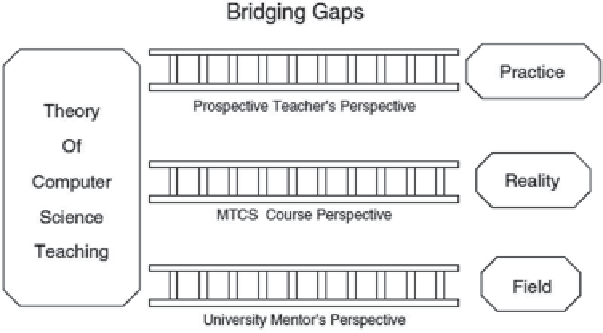Information Technology Reference
In-Depth Information
Fig. 13.1
Theory—practice/reality/field gaps.
MTCS
Methods of Teaching Computer Science
teaching themselves (in the broader sense, including lesson preparation, teaching in
the class or the computer lab, preparing and grading exams, etc.).
The involvement of the university mentor is usually expressed by periodic visits
to the schools in order to observe lessons taught by the prospective CS teachers. Re-
flection and feedback meetings take place after each such lesson. Thus, the university
mentor continues the guidance started in the MTCS course. In this sense, the practi-
cum can be viewed as one of the teaching methods employed in the MTCS course.
Usually, the students are asked to submit a report (a kind of reflection) about
their experience in the school. Sometimes, they are asked to carry out additional
activities such as, conducting some research, attending a workshop at the university
in parallel to the practicum, or participating in school faculty meetings.
13.2.2
The Practicum as a Bridge Between Theory
and Its Application
Hazzan and Lapidot (
2004
) examine the practicum through three lenses: the pro-
spective CS teacher's standpoint, the MTCS course viewpoint, and the university
mentor's perspective. For each perspective they highlight the importance of the
practicum by explaining how it helps bridge a specific gap related to the theory of
CS teaching (see Fig.
13.1
): a gap between theory and practice (the prospective CS
teacher's perspective), a gap between theory and reality (the MTCS course perspec-
tive), and a gap between theory and the field (the university mentor's perspective).
These three perspectives are explained in what follows.
13.2.2.1 Prospective Computer Science Teachers' Perspective:
Bridging the Gap between Theory and Practice
This perspective refers to the following questions: Why cannot we let the students
start teaching their own classes immediately after they finish studying the MTCS

Search WWH ::

Custom Search